Route 66. Just hearing the name makes me nostalgic for the days when I threw my tent and sleeping bag in the back of my 1969 Dodge Dart and headed west in search of adventure. I came by my romantic notions of travel quite naturally. Not only had I spent long hours poring over photos of exotic lands in the National Geographic Magazines piled up in our front hall, the television series Route 66 debuted in 1960 and quickly became a smash hit. I didn’t know it at the time but the name of the show was hugely misleading, as many of the episodes were set in states through which Route 66 did not travel. The bulk of the episodes, however, focused on the American West, leading me to believe that Route 66 was located in the western U.S.
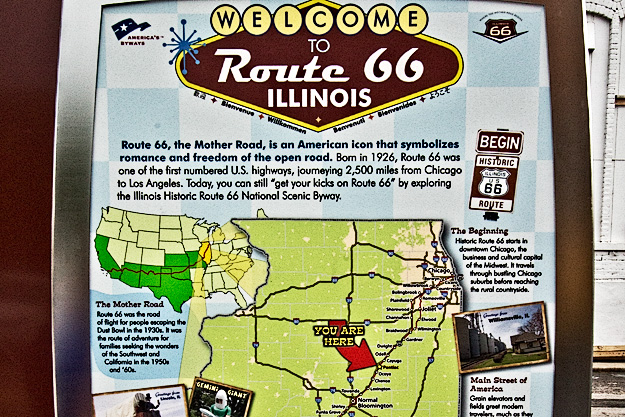
In truth, America’s Mother Road began in Chicago and ended in Los Angeles. Beginning in 1926, when the nation’s Federal highway system was authorized, it was cobbled together from a web of of existing local, State, and national roads; ultimately its 2,448 miles of pavement provided the primary connection between the Midwest and the Pacific Coast. As more and more families were able to afford cars in the years leading up to World War II, Route 66 came to represent freedom, adventure, and opportunity in the American psyche. This “Golden Era of the Automobile” lasted until 1956, when construction of the Interstate Highway System began and many sections of Route 66 were subsumed by the new superhighways. The last section of Route 66 was bypassed by Interstate 40 in 1984. A year later the last road signs were removed and U.S. Highway 66 was officially decommissioned. All along its route, the stores, motels, service stations, and roadside attractions that had depended upon the historic road for their livelihood went into decline, in many cases disappearing altogether.
Not long after I moved to Arizona in 1980, people began discussing what could be done to ensure that unique attractions like the Wigwam Motel in Holbrook, Arizona, where guests stay in a concrete wigwam, would not vanish forever. By the time I left Arizona eleven years later, my exposure to Route 66 was rooted in the American West, so when I came home to the Chicagoland area for the summer this year, I was completely taken aback when my sister, Nancy, suggested we visit the Route 66 Museum in Pontiac, Illinois.
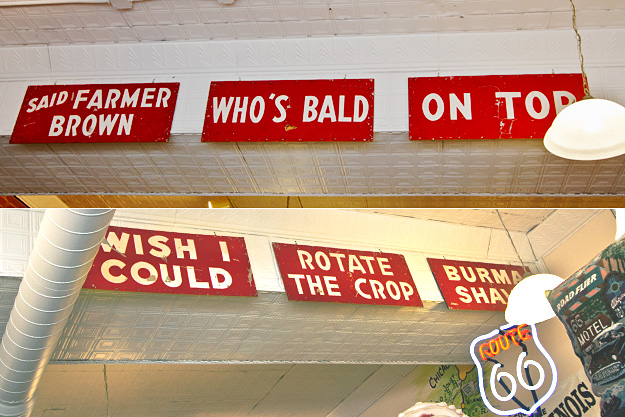
The museum was a time warp back to the 60’s. An old VW Bus stood in the center of the room, decked out for cross-country travel. Burma Shave signs hung from the ceiling. Memorabilia from each town along the Illinois route was displayed in glass cases along the wall. I had visited so many of the places shown in the old black and white photos, yet had never known they were icons along Route 66. How many times had I stood on the corner of Jackson and Michigan Avenue in downtown Chicago without realizing it was the starting point for the Mother Road? How could I have lived in Morris for ten years without knowing that I was surrounded by Route 66 history?
When I finally got over being flabbergasted, Nancy and I headed to the city center to search for some of the 20+ murals that adorn Pontiac’s old brick buildings. Most (but not all) have a Route 66 theme, including one that is 66-feet long and displays a map of the entire route from Chicago to L.A.
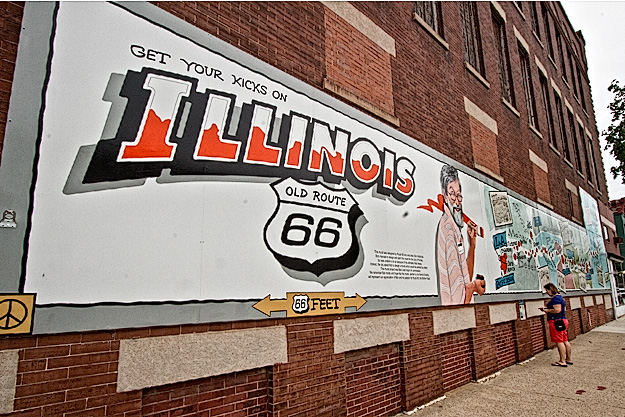
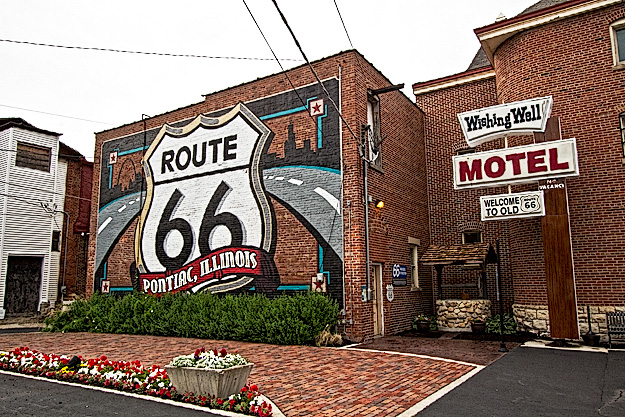
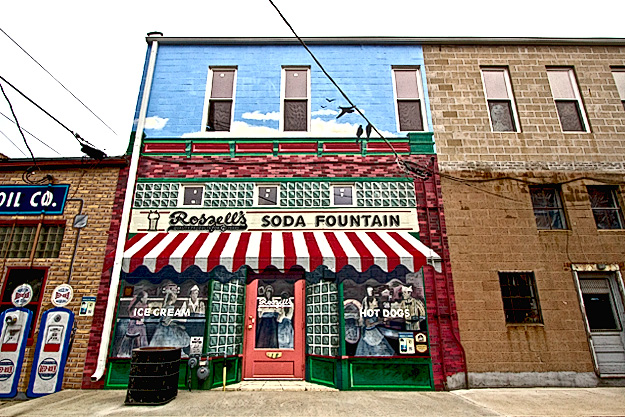
We visited the old Courthouse where Abraham Lincoln had represented clients, tried to find all the miniature cars scattered around town, and visited the Walldog Museum, dedicated to the men and women who paint murals like those found in Pontiac.

Not wanting the day to end, I had an inspiration. “Let’s drive all the way back on Route 66 rather than taking the Interstate!” Under threatening black skies we started home on the old two-lane. In Odell I dodged raindrops to photograph an old service station, complete with rusting pumps and a rare ‘winged-horse” Mobil sign. In Dwight we stopped at the Ambler/Becker Texaco Station, the longest operating gas station along Route 66. Phil and Deb Becker donated the station to the citizens of Dwight in 2004. Today it serves as the Visitor’s Center for the town. On the opposite corner, the Old Route 66 Family Restaurant advertised “Follow the Mother Road to Great Food.”
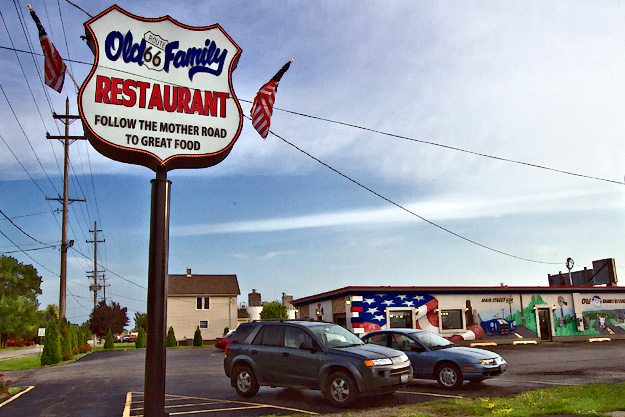
In Gardner we stopped to see the town’s original two-room jail and a replica of the Riviera Restaurant, a diner in a streetcar that served travelers until it burned down in 2010. From the Wayside Exhibit I learned that a resident of sleepy little Gardner helped turn the tide of war in our favor during World War II. Reverend Christian Christiansen emigrated from Norway in 1881, eventually settling in Gardner. One Sunday morning he read an article in the Chicago Tribune about a heavy water facility that the Nazis were building in the remote fjordlands of his native country. The location was impossible to bomb from above and the fjord was too narrow for a battleship to negotiate. If the facility could not be destroyed, Hitler would be the first to develop the atomic bomb.
The Reverend had been born in this area. As a youth he had hiked in those mountains and as a sailor he was intimately acquainted with its fjords and rivers. He contacted the U.S. Navy Department, who came to his home with maps of Norway. Christiansen was able to pinpoint the exact location of the plant and provide detailed instructions on how to reach it by land. The information was relayed to the British, who successfully destroyed the facility in February 1943.
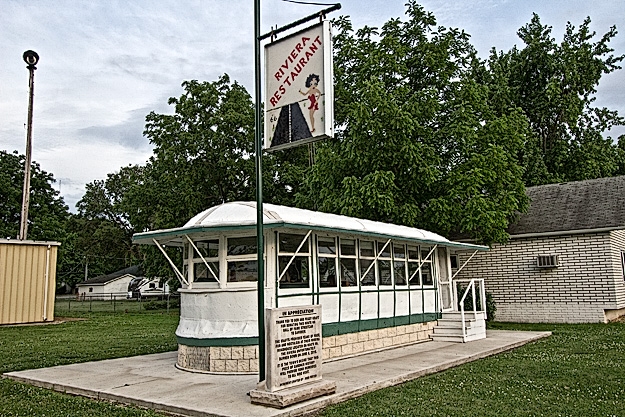
Dusk was falling and we were starving, so we sped off to our final stop, the Polk-A Dot Drive-In in Braidwood. We devoured chocolate malts and cheese fries amidst classic signs, antique jukeboxes, and assorted Route 66 memorabilia. Outside, a steady stream of cars rolled past fiberglass figures of Elvis Presley, Marilyn Monroe, Betty Boop, James Dean, and the Blues Brothers to place their orders at the drive-up window. Though the original school bus painted in rainbow polka dots is long gone, the restaurant, which has been in its current location since 1962, is still one of the most popular stops along this historic highway.

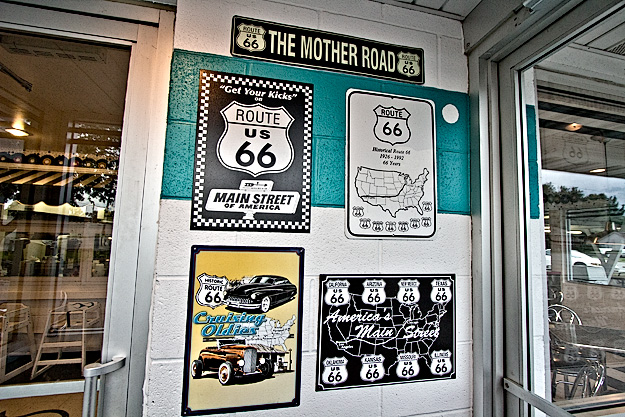
I would have loved to see the giant fiberglass man holding a space ship in Wilmington and tour the renovated Joliet Prison, made famous by the Blues Brothers movie, but we simply ran out of time. We only scratched the surface of what Route 66 has to offer, but now that I know Illinois gave birth to the roadway, I’m sure I’ll be visiting its most notable points of interest for years to come.

Best trip we ever had. And we’re sure we’ll do it again.
Hi Sylvia: I’ve only done parts of Route 66 in Illinois and Arizona – looking forward to doing the whole thing one day.
Over a period of 5 years (2007-2011), my son and I drove the length of Rt. 66. We spent one week each summer, picking up where we started the year before, averaging 100-120 miles per day. Great experience. We took a copy of Jerry McClanahan’s EZ Route 66 maps – hand-drawn and lettered, almost a work of art in itself – which allowed us to follow the historical alternative alignments of the old road. Carter (my son) was 12 when we started; I hope this remains one of his great memories of childhood. (And yes, we did stay in a teepee room, but it was the Wigwam Motel in San Bernardino, not the one in Arizona.) I hope you get back some day.
By the way, I’m 56 and maybe retired (long but not sad story). If so, I hope to start doing what you’ve done the last several years.
Inspiring.
Thanks.
Hi Dave: Ah! Another potential convert to a life of perpetual travel. I hope you do it – you’ll find it intensely rewarding, exciting, and interesting. Thanks so much for sharing your recollections of your Route 66 trip. One of these days I’m going to get back to traveling in the U.S. and do the entire length myself, hopefully with the same map you used.
Never traveled America, but I’m pretty sure when I do reach that part of the world, this is how I want to do. Although a lot of my American friends always tell me not to, just because you still miss so much. I guess its impossible to see it all and that’s why we’ve always got to revisit!
Hi Jamie: Well, I’d probably disagree with your friends. You might miss some of the “iconic” sights by traveling the back roads, but there’s no better way to experience the “real” America.
I would love to drive the length of this road one summer – maybe after I finish up my round the world excursion in a couple of years…
Something I’d like to do as well, Adam, maybe in a small van-size RV. So many places, so little time.
A book and a song has done so much for this famous route through the US.
And a TV show!
I just happened upon this post serendipitously. Love Route 66. Until the early 1930s it went through Santa Fe and we still have some landmarks here. We’re been on portions of what’s left. One day would love to drive what we can from Chicago to LA one day- a lot of foreign bikers do it every year. The road’s so iconic! The museum looks great. I still remember Burma Shave signs on the road in my youth. Miss them!
Hi Santa Fe Traveler. I’m with you – some day I will drive the entire length, and stay in one of those teepee rooms in Arizona!